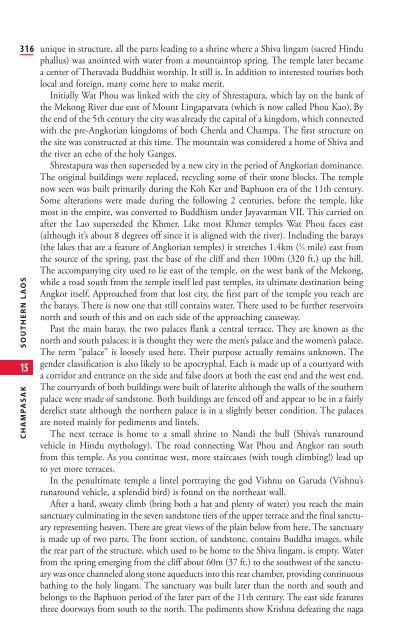Create successful ePaper yourself
Turn your PDF publications into a flip-book with our unique Google optimized e-Paper software.
316<br />
SOUTHERN LAOS<br />
15<br />
CHAMPASAK<br />
unique in structure, all the parts leading to a shrine where a Shiva lingam (sacred Hindu<br />
phallus) was anointed with water from a mountaintop spring. <strong>The</strong> temple later became<br />
a center <strong>of</strong> <strong>The</strong>ravada Buddhist worship. It still is. In addition to interested tourists both<br />
local and foreign, many come here to make merit.<br />
Initially Wat Phou was linked with the city <strong>of</strong> Shrestapura, which lay on the bank <strong>of</strong><br />
the Mekong River due east <strong>of</strong> Mount Lingaparvata (which is now called Phou Kao). By<br />
the end <strong>of</strong> the 5th century the city was already the capital <strong>of</strong> a kingdom, which connected<br />
with the pre-Angkorian kingdoms <strong>of</strong> both Chenla and Champa. <strong>The</strong> first structure on<br />
the site was constructed at this time. <strong>The</strong> mountain was considered a home <strong>of</strong> Shiva and<br />
the river an echo <strong>of</strong> the holy Ganges.<br />
Shrestapura was then superseded by a new city in the period <strong>of</strong> Angkorian dominance.<br />
<strong>The</strong> original buildings were replaced, recycling some <strong>of</strong> their stone blocks. <strong>The</strong> temple<br />
now seen was built primarily during the Koh Ker and Baphuon era <strong>of</strong> the 11th century.<br />
Some alterations were made during the following 2 centuries, before the temple, like<br />
most in the empire, was converted to Buddhism under Jayavarman VII. This carried on<br />
after the Lao superseded the Khmer. Like most Khmer temples Wat Phou faces east<br />
(although it’s about 8 degrees <strong>of</strong>f since it is aligned with the river). Including the barays<br />
(the lakes that are a feature <strong>of</strong> Angkorian temples) it stretches 1.4km ( 3 ⁄4 mile) east from<br />
the source <strong>of</strong> the spring, past the base <strong>of</strong> the cliff and then 100m (320 ft.) up the hill.<br />
<strong>The</strong> accompanying city used to lie east <strong>of</strong> the temple, on the west bank <strong>of</strong> the Mekong,<br />
while a road south from the temple itself led past temples, its ultimate destination being<br />
Angkor itself. Approached from that lost city, the first part <strong>of</strong> the temple you reach are<br />
the barays. <strong>The</strong>re is now one that still contains water. <strong>The</strong>re used to be further reservoirs<br />
north and south <strong>of</strong> this and on each side <strong>of</strong> the approaching causeway.<br />
Past the main baray, the two palaces flank a central terrace. <strong>The</strong>y are known as the<br />
north and south palaces; it is thought they were the men’s palace and the women’s palace.<br />
<strong>The</strong> term “palace” is loosely used here. <strong>The</strong>ir purpose actually remains unknown. <strong>The</strong><br />
gender classification is also likely to be apocryphal. Each is made up <strong>of</strong> a courtyard with<br />
a corridor and entrance on the side and false doors at both the east end and the west end.<br />
<strong>The</strong> courtyards <strong>of</strong> both buildings were built <strong>of</strong> laterite although the walls <strong>of</strong> the southern<br />
palace were made <strong>of</strong> sandstone. Both buildings are fenced <strong>of</strong>f and appear to be in a fairly<br />
derelict state although the northern palace is in a slightly better condition. <strong>The</strong> palaces<br />
are noted mainly for pediments and lintels.<br />
<strong>The</strong> next terrace is home to a small shrine to Nandi the bull (Shiva’s runaround<br />
vehicle in Hindu mythology). <strong>The</strong> road connecting Wat Phou and Angkor ran south<br />
from this temple. As you continue west, more staircases (with tough climbing!) lead up<br />
to yet more terraces.<br />
In the penultimate temple a lintel portraying the god Vishnu on Garuda (Vishnu’s<br />
runaround vehicle, a splendid bird) is found on the northeast wall.<br />
After a hard, sweaty climb (bring both a hat and plenty <strong>of</strong> water) you reach the main<br />
sanctuary culminating in the seven sandstone tiers <strong>of</strong> the upper terrace and the final sanctuary<br />
representing heaven. <strong>The</strong>re are great views <strong>of</strong> the plain below from here. <strong>The</strong> sanctuary<br />
is made up <strong>of</strong> two parts. <strong>The</strong> front section, <strong>of</strong> sandstone, contains Buddha images, while<br />
the rear part <strong>of</strong> the structure, which used to be home to the Shiva lingam, is empty. Water<br />
from the spring emerging from the cliff about 60m (37 ft.) to the southwest <strong>of</strong> the sanctuary<br />
was once channeled along stone aqueducts into this rear chamber, providing continuous<br />
bathing to the holy lingam. <strong>The</strong> sanctuary was built later than the north and south and<br />
belongs to the Baphuon period <strong>of</strong> the later part <strong>of</strong> the 11th century. <strong>The</strong> east side features<br />
three doorways from south to the north. <strong>The</strong> pediments show Krishna defeating the naga










